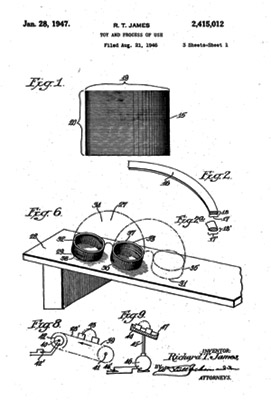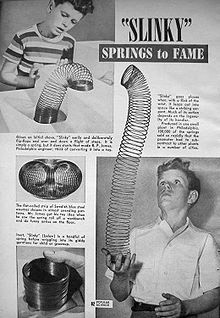 In 1943, Richard James, a naval engineer stationed at the shipyard in Philadelphia, was working on an anti-vibration device for ship instruments. Part of the device involved high-tension springs. Richard accidentally knocked one of the springs off of a shelf. He watched as the spring kept moving, walking and flip-flopping after it hit the ground. The idea for a new toy was born.
In 1943, Richard James, a naval engineer stationed at the shipyard in Philadelphia, was working on an anti-vibration device for ship instruments. Part of the device involved high-tension springs. Richard accidentally knocked one of the springs off of a shelf. He watched as the spring kept moving, walking and flip-flopping after it hit the ground. The idea for a new toy was born.
Richard shared his idea with his wife, Betty. She was unsure about the idea at first but her mind was changed when her young son and the neighborhood kids expressed interest in the spring. Richard spent the next two years perfecting the toy. He determined what was the best gauge of steel and coil to make the spring. The new toy was made of eighty feet of Swedish wire.
Betty James provided the name for the new toys. She called the new toy “Slinky” after discovering the Swedish word means sleek and graceful. She also thought the word described the noise of the metal spring as it walked by expanding and collapsing.
 The couple formed their business, James Spring and Wire Company, with a five hundred dollar loan. They had four hundred of the new toys made by a local machine shop. In the beginning, toy stores were uninterested in the product. Then in November of 1945, James gave a demonstration of the new toy at Gimbels department store in Philadelphia. Richard was very nervous about this demonstration and asked a friend to buy the first slinky. There was no need for Richard to be nervous though. The slinky was an instant hit. The first four hundred toys priced at one dollar a piece sold in less than ninety minutes.
The couple formed their business, James Spring and Wire Company, with a five hundred dollar loan. They had four hundred of the new toys made by a local machine shop. In the beginning, toy stores were uninterested in the product. Then in November of 1945, James gave a demonstration of the new toy at Gimbels department store in Philadelphia. Richard was very nervous about this demonstration and asked a friend to buy the first slinky. There was no need for Richard to be nervous though. The slinky was an instant hit. The first four hundred toys priced at one dollar a piece sold in less than ninety minutes.
Richard James applied for a patent for a toy and process of use on August 21, 1945. Patent #2,415,012 was issued to him on January 28, 1947.
By 1946, Richard had quit his job to devote all of his energy to the new company. He designed a machine to produce the toy. A plant was opened in Philadelphia. Today the Slinky is made in Hollidaysburg, Pennsylvania using the same equipment designed by Richard James.
More than 300 million Slinkys have been sold since the introduction of the toy. Slinkys have seen many other uses as well. Teachers have used them to demonstrate the properties of waves. US Troops in Vietnam used them as mobile radio antennas. NASA has included them in zero-gravity experiments in Space Shuttles.
What walks down stairs, alone or in pairs, and makes a slinkity sound?
A spring, a spring, a marvelous thing! Everyone knows it’s Slinky.
It’s Slinky, it’s Slinky. For fun it’s a wonderful toy.
It’s Slinky, it’s Slinky. It’s fun for a girl or a boy.
It’s fun for a a girl or boy!”
